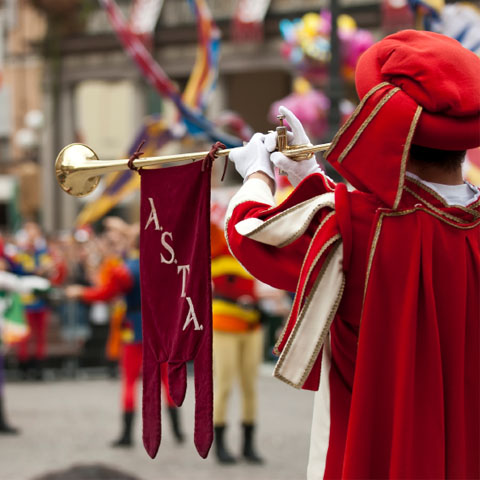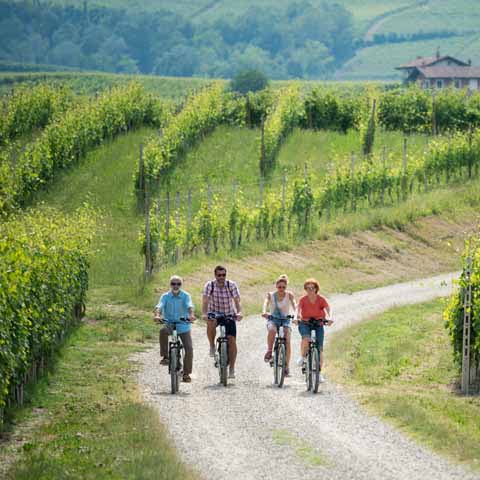Asti is a small Italian city primarily famous for its delicious wines and flavorful cuisine. It is settled in Piedmont and is the capital of the homonymous province in the region. Counting a little over 70,000 souls, this town is not only renowned for wines and good food, as it also has a rich history.
Until a few decades ago, many scholars believed the name Asti derived from the Ligurian word ast, used to describe the inhabitants of a settlement on a hill. In fact, it is believed that Asti means rock that rises from a plain, and owes its name to its allegedly Ligurian origins.
PREHISTORY OF ASTI
Asti has always been considered a city founded by the Romans, but evidence suggests that the first civilizations to ever settle in this place were the Ligurians, hence the Ligurian name. The first people that laid the foundation of the future Roman settlement were shepherds, craftsmen, and farmers.
However, the origins of the town could be much older. Historical evidence has irrefutably demonstrated the existence of vast and well-structured settlements dating to the Iron Age, both along the Tanaro and Belbo valleys.
The civilizations here only got close to the Latin world in the second century BC; another clear indication of the Ligurian origins is the initial existence of another Asti, now disappeared, in the Ligurian Riviera.
According to other scholars, Asti has even older origins. Some believe it was founded in the Neolithic era, on the left bank of the Tanaro River, from where the inhabitants moved in the Varroni hillock between 1800 and 1500 BC.
Artifacts belonging to the Veio culture also lead us to assume an Etruscan presence in the region between 1000 and 600 BC. However, the lack of evidence of regular commercial exchanges with Etruria makes it hard to understand Asti’s position in the era.
What is certain is that the local Ligurian substratum mixed with the Celtic culture and shaped a Celtic language and customs until the arrival of the Romans.
The Romanization process lasted between 200 and 122 BC, a period in which Asti and its territory were constituted into a Roman municipium. During the Roman age, the settlement was given the name of Hasta, and the remains from the era demonstrate the strategic role the town played in the Empire.
Some of the most important findings include tombstones and glass vases, as well as terracotta pots, furnishings, and a few remarkable marble remains. Architectural remains indicate the presence of a Roman amphitheater, as well as a Domus and a vast area of baths, a Roman forum, and several stretches of urban paved roads.
All these remains show the strategic importance the Romans gave this settlement, which was placed on the consular road coming from Dertona and leading to other parts of the Empire.
HISTORY OF ASTI
With the fall of the Roman Empire and the arrival of the Lombards in 568, Asti and its region became part of the Duchy of Nescia, extending from Piedmont to Liguria. The administration of the Duchy was assigned to Gunualdo, whose sons and successors were so involved in a perpetual conflict that their weakened power allowed Grimoaldo, the Duke of Benevento, to take advantage of it and assume the role of leader in the region.
Nevertheless, the passage from the Roman Empire to Lombard domination was not as traumatic in Asti as it was in other parts of Italy. However, the nobility was still forced to flee, and their property was confiscated for the new patrician class.
These events led to a notable demographic and economic decline, which downgraded the city from civitas to civitatula.
The Lombard domination ended in 774 with the arrival of Charlemagne. His arrival came with new titles and privileges to the nobility of Asti. Among the privileges accorded to the city, was the Fair of Asti and the Fair of Carolingia, which at the time was held twice a year.
But this quaint period did not last for long. In 815, with the death of Charlemagne, the Holy Roman Empire crumbled Asti and its territory into countless small fiefdoms, each of whom claimed rights over several territories.
Asti became increasingly engaged in struggles for succession and supremacy while witnessing an always higher episcopal influence.
The city enjoyed the presence of cultured bishops though; people would treat them with respect and popular benevolence, and for this reason, the emperors tried to use them in the evolutionary process of feudalism.
In order to contain the bishops under their authority, the rulers granted them with goods and privileges which concluded, under Otto I, with the investiture of Bishop Brunigo as lord of the city, responsible for administrative and judicial power.
But the bishops of Asti never lost their spiritual dignity and mission, and under their government, they improved the socio-economic conditions of the city and slowly surrendered power to the civil Municipality of Asti.
The Municipality immediately engaged in an expansionist economic policy, which involved creating new commercial links with Europe. This policy was not seen in a good light by other lands’ bishops or feudal families, leading Asti to stand, for a short period, against the municipalities of the Lombard League.
In an attempt to defend itself, Asti tightened alliances with Pavia and Genoa; however, what followed was a period of bitter clashes which culminated in 1275 when the troops of Anjou suffered serious losses.
After this grim period, the city finally reached its peak of splendor in the twelfth century. During these years, Asti built considerable city walls; the noble families built towers as a symbol of their economic and military power, while the economic power also developed thanks to the powerful merchant families who established partnerships with many municipalities in the Alps.
Their activity spread like wildfire throughout Europe, with the first permanent settlement of pawn shops in France, Germany, and the Flanders region of Belgium.
This made Asti the eighth greatest power among the Northern Italian cities in the thirteenth century. Elevated now to the rank of papal bankers, the merchants in Asti were considered the richest of all Italians.
However, the expansionist ambitions were cut down due to deep divisions between the Guelph and Ghibelline factions of the Asti families.
The fights lasted for almost a century, and this state of feuds, murders, and reprisals weakened the municipality. The political and economic expansion was brought to an end, and in a short time, the government passed to the Visconti family, then, following the marriage of Valentina Visconti with the Duke of Orleans, the city passed under French domination.
Under the Orleans though, Asti had a flourishing period and knew a true economic recovery that quickly came to an end following the imprisonment of Charles of Orleans. After years of struggles and after the return of the Duke, the city got its own regent, then passed to the court of France.
Under the rule of Louis XII, Duke and son of Charles, Asti closed an alliance with Venice and the Pope. After the Battle of Ravenna, the city passed under Sforza rule, but then returned to France in 1515.
In 1531, the city was donated to Beatrice of Portugal, the cousin of Charles V and wife of the Duke of Savoy.
Under the Savoy, Asti regained many of its lost privileges, but still struggled under the many battles between its rulers and the Spanish Emperor. In the upcoming century, the city was torn by war.
In 1723, the dynamic Jewish community in Asti was moved into a ghetto, and in 1748, following the peace of Aachen, the city entered once again into a period of stability. Things took a turn for the worse once more though, following the outburst of the French Revolution.
After endless struggles, on July 28, 1797, the citizens of Asti tired of the Savoy and were exhausted by the military operations. The citizens rebelled against the government and proclaimed the Republic of Asti. A new administration was set up, and the military commander of the city handed the weapons to the rioters, surrendering the command of the castle.
The beginning of the nineteenth century arrived with the Napoleonic domination, finding Asti and Piedmont exhausted by the war. Riots and opposition broke out throughout the region. Soldiers started to indulge in acts of vandalism, and all these facts led to the development of banditry.
In 1814, after the defeat of Napoleon and the restoration of the European power for the Savoy, Asti entered into a period of political and economic recession, which increased poverty even more. And as if this were not enough, an epidemic of typhus and smallpox weakened the position of the city even more.
The second part of the century came with important urban transformations. Asti lost most of its city walls but gained new cultural and economic institutions. The abolition of the ghetto also favored the rise of a prosperous Jewish community, while the development of industrialization also attracted new inhabitants.
At the beginning of the twentieth century, Asti gained the title of the provincial capital, but the arrival of World War II brought scarcity of products with a consequent increase of prices. Air raids also damaged most of Asti’s countryside.
After the war, a worrying tendency of the peasant population to abandon the countryside for the city emerged, and the industrialization process resumed. The establishment of FIAT and consequent development brought some prosperity to the city, while the development of nearby Turin also had a more than positive influence on Asti.
From the last decades of the twentieth century, Asti also began to focus on services and reinvented itself, investing mainly in the wine and gastronomic industries. Today, Asti is mostly famous for its delicious sparkling wine, and the municipality shows impressive efforts in growing the service and tourism sectors in the area.
ARCHAEOLOGY IN ASTI
Archaeological research in recent years has led to the discovery of important Roman vestiges scattered throughout the city. Perhaps the most important from an archaeological point of view is the Roman amphitheater, probably built in the first century AD.
Important evidence from the same period includes the archaeological site of the Roman Domus, which consists mainly of the remains of a dwelling used by Roman families. An exciting artifact here is a beautifully preserved floor mosaic enriched with vegetal and animal elements.
The crypt in the Diocesan Museum of San Giovanni is another noteworthy place from an archaeological point of view. The crypt is rather new, but it is almost completely built from recycled Roman materials. Furthermore, the construction also includes two Corinthian elements and three Egyptian bricks.
Besides these archaeological sites, Asti also features a wealth of vestiges in the Archaeological Museum and the Local Paleontological Museum of the Asti Area.
The former comprises vast collections of artifacts found scattered throughout the territory, while the latter focuses more on the territorial paleontology, describing the geological periods between the Miocene and Pliocene epochs.
Asti apart, the entire province is also full of archaeological evidence and remains from the various populations, including artifacts from the early Ligurian and Etruscan periods.
Don't just see Italy, live it.
Your dream trip to Italy has never been closer
No more endlessly scrolling travel sites. Our travel experts will craft the perfect, one-of-a-kind trip just for you.

300+
DESTINATIONS
We offer more Italian destinations than any travel site. Do and see more with Trips 2 Italy.
1 (of a kind)
ITINERARIES
Because your dream trip to Italy should be designed for you, not for the masses.
100%
PEACE OF MIND
From flights and accommodations, to food and activities - we take care of every detail.






